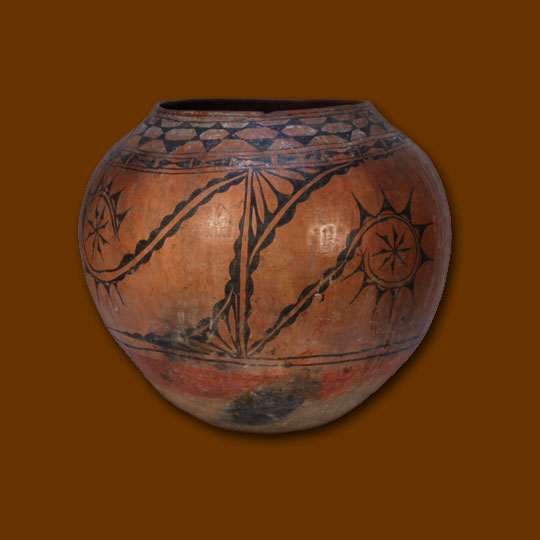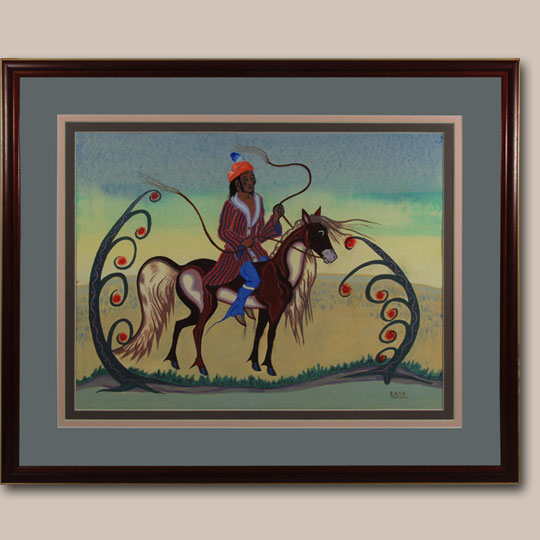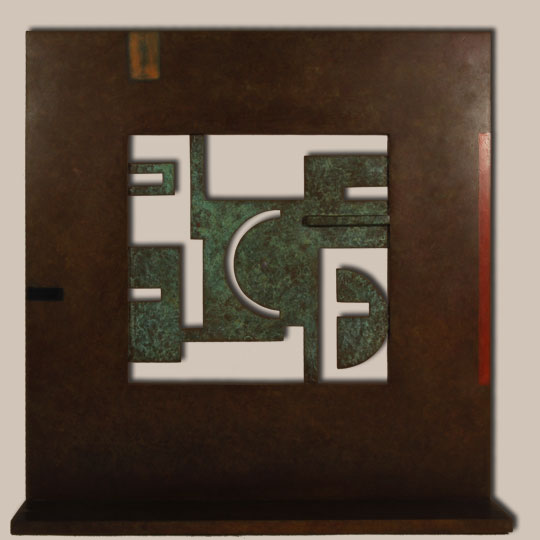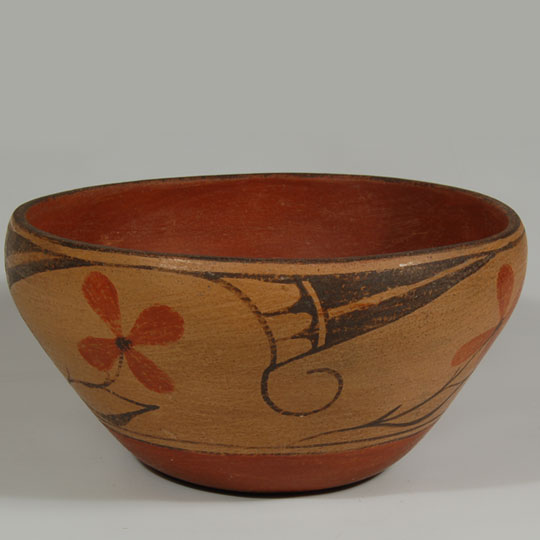Very Large Historic Cochiti Pueblo Storage Jar - C3758A
 The historic period of pueblo pottery has been defined as beginning with the first contact with Europeans in 1540, the reasoning being that it was the Europeans who began documenting events, creating a history of the area, which was a logical beginning of the historic pottery period. At that time, pueblo potters made pottery for their own use and as a trade item to members of other pueblos or tribes.
The historic period of pueblo pottery has been defined as beginning with the first contact with Europeans in 1540, the reasoning being that it was the Europeans who began documenting events, creating a history of the area, which was a logical beginning of the historic pottery period. At that time, pueblo potters made pottery for their own use and as a trade item to members of other pueblos or tribes.
With the arrival of the Spanish, the market for pueblo pottery greatly increased as it was easier and smarter to procure pottery from local pueblo potters than to wait for imports to arrive on the Camino Real from Mexico City, a journey that took over 6 months to complete. New shapes and new sizes of pottery were developed to satisfy the needs of the new markets. Large storage jars were standard measurements of volume to facilitate trade of wheat or grains to the market. In some cases, the historic jar in which the grain was stored was given with the sale of the grain as it was considered only a container of the product being sold. One wonders if the purchaser of a jar full of grain used the product then discarded the container.
Original Painting of a Cherokee Indian on Horseback by Cecil Dick - C3755D
 As a small child, Cecil Dick spoke only Cherokee. He was orphaned at age 12 and reared in Indian boarding schools. He was considered an authority on Cherokee mythology and the Cherokee written language. He attended the Santa Fe Indian School for one year, did not like the school's flat painting style, and chose to paint in the Woodlands style with the plants, trees, and hills that were part of his Woodlands experience. He was allowed to do so. After one year in Santa Fe, he returned to Oklahoma.
As a small child, Cecil Dick spoke only Cherokee. He was orphaned at age 12 and reared in Indian boarding schools. He was considered an authority on Cherokee mythology and the Cherokee written language. He attended the Santa Fe Indian School for one year, did not like the school's flat painting style, and chose to paint in the Woodlands style with the plants, trees, and hills that were part of his Woodlands experience. He was allowed to do so. After one year in Santa Fe, he returned to Oklahoma.
Dick did not paint on a regular basis at any time during his career. He painted when he felt like doing so and, as a result, his work is relatively rare. He also worked as a sign painter and a draftsman, another reason for not executing many art paintings.
Bronze Sculpture “Kachina Symbolism I” by Dan Namingha - C3769A
 Dan Namingha is well-known as a painter but he has a strong presence in bronze sculpture as well. His sculptures have been executed in wood and bronze. In the 1990s he formulated a series of bronze sculptures relating to Kachinas. He executed a series of bronze sculptures entitled Kachina Symbolism. This sculpture measures approximately 18 x 18 inches, with a pedestal that is 6-1/8" deep. A very similar larger one was cast in 1997 at 50 x 48 x 16 inches.
Dan Namingha is well-known as a painter but he has a strong presence in bronze sculpture as well. His sculptures have been executed in wood and bronze. In the 1990s he formulated a series of bronze sculptures relating to Kachinas. He executed a series of bronze sculptures entitled Kachina Symbolism. This sculpture measures approximately 18 x 18 inches, with a pedestal that is 6-1/8" deep. A very similar larger one was cast in 1997 at 50 x 48 x 16 inches.
Contemporary Large Serving Bowl from Zia Pueblo - C3753.22
 This is a beautifully executed serving bowl from Zia Pueblo, created most likely in the mid-20th century. This excellent medium-size bowl was coil-formed of native clay with the addition of crushed basaltic temper. The underbody bare paste was stone-polished to a warm brick red color. The design field was covered in soft orange slip over which was painted the design of floral elements. The rim of the bowl curves inward just so slightly and displays a very slight concave slope.
This is a beautifully executed serving bowl from Zia Pueblo, created most likely in the mid-20th century. This excellent medium-size bowl was coil-formed of native clay with the addition of crushed basaltic temper. The underbody bare paste was stone-polished to a warm brick red color. The design field was covered in soft orange slip over which was painted the design of floral elements. The rim of the bowl curves inward just so slightly and displays a very slight concave slope.
Original Painting "Moonrise Over the Sangre de Cristos" by Glenn Dean - C3768
Glenn Dean decided early in life to become a painter and although he took a couple of workshops in outdoor painting, he basically is a self-taught artist. He chose to self-study the great California artists, particularly Maynard Dixon and Edgar Payne whom he felt painted scenes as they were meant to be painted. He paints on location and particularly likes the landscapes of the Southwest for subject matter.
In this painting, one's mind cannot help but revert back to Ansel Adams' "Moonrise Over Hernandez," as an inspiration for this title, but the similarities end there. Dean has beautifully presented the low adobe homes nestled in the foothills of Santa Fe's Sangre de Cristo mountain range. The homes blend into the landscape with their earth colors and snuggle beneath the pink hues of the sky and the purple of the range. An excellent representation of the facts that exist.
Oil Painting of Landscape with Aspens and Deer by Jake Haverstick - 25312
Artists sometimes struggle in their chosen career as painters, but Jake Haverstick was fortunate in the 1930s to make the acquaintance of famous Taos artist W. Herbert Buck Dunton, one of the founders of the Taos Society of Artists. Dunton mentored the young Haverstick until he felt he no longer needed instruction.
Haverstick and his family then moved from Taos to Albuquerque where they stayed until both he and his wife passed away. Haverstick's wife, Fay, made wooden hand carved frames for his paintings. Fortunately, this painting still retains the hand carved frame made by Fay Haverstick.
Cochiti Pueblo Sterling Silver Concha Belt by Silviano Quintana - C3276
The Navajo are best known for production of concha belts, but pueblo silversmiths also made them. Joe Quintana and Silviano Quintana are known to have made them-some signed and others not. This concha belt was examined on October 18, 2013 by Cochiti jeweler Cippy Crazyhorse, son of Joe Quintana, who stated that he thought this was made by Silviano Quintana.
Would you like to know more?
Oil on Canvas “Badger Kachina” by Dan Namingha - C3769B
Dan Namingha is from the Hopi-Tewa village at First Mesa. He is a member of the famous Nampeyo family. His mother is Dextra Nampeyo and his grandmother was Rachel Namingha Nampeyo. He was born in 1950 and attended High School at Keams Canyon, Arizona, the University of Kansas and then the Institute of American Indian Arts in Santa Fe where he came under the influence of Otellie Loloma who encouraged him to experiment with his art. He began his art career painting in realistic style and then, around 1972, began to paint in a more abstract manner. Teachers at IAIA, such as Otellie Loloma, Allan Houser, and Fritz Scholder, encouraged the students to expand their horizons and paint creatively, which many did.
Would you like to know more?
Very Large Pottery Jar from Kewa Pueblo by Vidal Aguilar - C3765A
This large storage jar was purchased by the current owner directly from the potter about 15 years ago and the artist told him at that time that it was used in the kiva for holding water but he would sell it since he made it and owned it.
According to Gregory Schaaf, in the referenced book below, "Vidal Aguilar makes some of the largest polychrome ollas at Santo Domingo in the Aguilar family tradition. His pottery is hand coiled and polished. His black paint is a mineral pigment used centuries ago, rather than the typically used Guaco or Mountain Bee plant. His red & white paints are natural clay. He fires his pottery in a pit."
Large Black-on-Cream Aguilar-Style Olla by Harlan Reano and Lisa Holt - C3310J
Felipita Aguilar Garcia was the inspiration behind a quiet revolution in pottery designs at Santo Domingo (now Kewa) Pueblo between 1905 and 1914. She, and her sister, Asunción Aguilar Caté, developed a new style of pottery design. Felipita favored the strong black with thin cream lines and Asunción favored the black and red with thin cream lines.
Several potters have occasionally designed jars similar to Felipita's. Monica Silva and Robert Tenorio of Kewa Pueblo and Lisa Holt of Cochiti with Harlan Reano of Kewa have produced similar pieces.
Would you like to know more?
Santa Clara Pueblo Large Polished and Carved Red Jar by LuAnn Tafoya - C3766C
Lu Ann Tafoya, a daughter of Margaret Tafoya, certainly inherited the talent to produce beautifully sculpted jars with outrageously burnished surfaces. She has made jars almost three feet tall, a feat not easily accomplished. Her grandmother, Sara Fina Tafoya, was a masterful potter, as was her mother, Margaret Tafoya, who, in turn, passed on this artistic gene to nine children and numerous grandchildren.
Santa Clara Pueblo Red Pottery Candlestick - 25581
Polished red candlesticks seem to be rarer than polished black ones, perhaps because blackware was so popular in the mid-20th century when most Southwest Indian Pottery candlesticks were being made. This one from Santa Clara Pueblo is tall and graceful and decorated simply with white-outlined red triangles. It shows evidence of prior use.
Would you like to know more?
Highly Polished Santa Clara Black Bear Paw Jar by Sara Fina Tafoya - C3551Y
Sara Fina Tafoya (circa 1863-1950) Autumn Leaf was from Santa Clara Pueblo and she made large utilitarian vessels and small items as well. Most were undecorated polished black or red pottery, and some had scalloped rims and impressed designs including bear paws and melon shapes.
Her work today must be attributed to her hand by comparing them to pieces in collections which are known to have been made by her. Because of the high quality of her pottery, it is not too difficult to single out her work.
Kewa Pueblo Large Historic Polychrome Storage Jar - SC2922B
This vessel is larger than traditional water jars and is more in line with the vessel shape of a storage jar, so that is the designation we have assigned to it. It exhibits the classic traits of Santo Domingo Polychrome. We are assigning a date of circa 1900-1920 to the jar based on the stone-polished red band below the design field and the same on the interior of the neck.
Would you like to know more?
Historic Large Zuni Polychrome Jar with Red Parallel Lines - C3767
There have always been strict guidelines at Zuni Pueblo regarding pottery decoration, yet each potter has also always had some degree of freedom. The things that seem to be traditional and inflexible are the manner in which the main body decoration and that of the neck are separated. According to Zuni informants to Ruth Bunzel in 1924 and 1925, it is imperative that the first bit of decoration that goes on any Zuni jar be the black framing line or pair of framing lines that separate the neck from the main body. It is also imperative that this line or pair of lines not be connected. Today we refer to this as a ceremonial break. The informants were explicit in these statements. Another noticeable aspect on Zuni jars is that there is no correlation between the design of the neck and that of the body of the vessel, except that a certain harmony is preserved between the two.
Would you like to know more?
Black-on-black Tall-neck Jar signed Blue Corn by Crucita Gonzales Calabaza - C3766B
Blue Corn was born in San Ildefonso Pueblo around 1921 and was encouraged by her grandmother, at an early age, to "forget school and become a potter." She did attend school at the pueblo and later at the Santa Fe Indian School, however. At age 20, she married Santiago Calabaza, a Kewa Pueblo (Santo Domingo) silversmith. During the 1940s, she worked at Los Alamos as a housecleaner for J. Robert Oppenheimer. Shortly after World War II, she took up pottery making and found her calling.
Would you like to know more?
Santa Clara Pueblo Large Micaceous Jar with Fluted Rim by Lee Moquino - C3765B
There is a large Moquino family at Santa Clara Pueblo but I have not yet found to which family Lee Moquino belongs. He has been making pottery for some time as this one was purchased about 2005. Not many potters at Santa Clara Pueblo make micaceous pottery as that is more often made at the more northern pueblos.
Would you like to know more?
Traditional Sikyatki Revival Design Jar signed Dextra - C3766A
In the 1960s and 1970s, Dextra Quotskuyva Nampeyo worked with her mother, Rachel Namingha, and painted on her pottery the traditional Sikyatki designs made famous by the Nampeyo family. She continued this for a number of years, yet she never repeated the same design, ever, according to her. Later she developed her own unique style of design which she continued using throughout her career.
Would you like to know more?
Adobe Gallery is on You Tube
If you don't know Adobe Gallery has a you tube channel. We have videos of artist that visit the gallery, special items that we thought need to be seen more fully, and what happening around the gallery. Click the logo and check it out.
Opening Reception: NAVAJO RUGS FROM CRYSTAL TRADING POST ca. 1920-1940
An exhibit of Navajo rugs from Crystal Trading Post in northern New Mexico that date from the 1920s to the 1940s opens at the gallery on Friday evening, June 3rd with a reception from 5 to 7 pm.
Crystal Trading Post gained its reputation at the end of the 19th century when trader J. B. Moore purchased the post and set about to be a career Navajo trader. Because the weather in the Chuska Mountains, where the post was located, was severe in the wintertime, few visitors ever showed up so Moore decided to create a mail order business with Navajo arts and crafts.
To make his mail order business work, Moore created a full-color mail order catalog in 1903 featuring Navajo rugs, jewelry, and miscellaneous objects. It apparently was successful, so in 1911, he published his second catalog. The combination of the two catalogs featured 31 Navajo rugs from which a client could order by mail and Moore would select the appropriate Navajo weaver to make the rug according to the size, quality, and price specified by the client. He also advertised jewelry, tableware, baskets and other art objects which also could be ordered.
In 1987, the publishing division of Adobe Gallery put together the old J. B. Moore mail order catalogs and published them as a new publication. As a natural follow-up to that, the gallery staff decided to search for a rug from each of the 31 illustrations in the catalog. It took several years, but when the collection was completed, a client purchased the entire group.
The rugs in this exhibit are not from the catalog examples, but from the 1920s to the 1940s, the period after Moore left the post and moved to California. Some of the same general design elements were retained by the weavers and new ones were introduced. Change came slowly to the weavers so many of the Moore designs can be seen in the textiles in this exhibit. It was not until the 1960s when the last vestiges of Moore's influence on Navajo weaving ended.
The exhibit will continue until August 6th.
Questions may be referred to the gallery at 505.955.0550 or by email: info@adobegallery.com. Previews of all rugs may be seen online: https://www.adobegallery.com/shows/current


